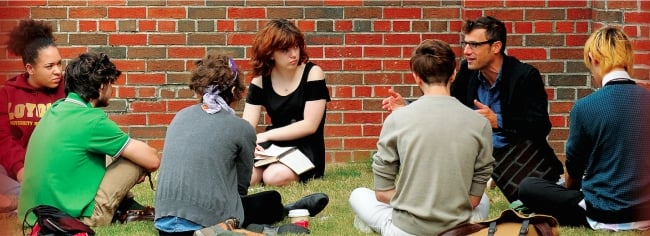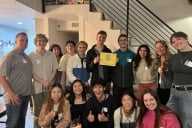You have /5 articles left.
Sign up for a free account or log in.

Christopher Schaberg teaches a class outside.
Harold Baquet
I use the internet for a lot of things. I’ll publish this piece online, and I’ll promote it there, too. I chat with friends, students and colleagues on Twitter. I’ll do my banking online and sometimes even shop there.
But I’ll never teach online.
I understand the value of online offerings for certain required courses and professional programs, and for reaching students who may not have the ability to get to a college campus. I appreciate that online courses can function as a supplement, as a workaround for real challenges that real people face as they attempt to earn degrees.
Yet there are several things I can’t do in my class on the internet, and these are why I won’t be found teaching online, not ever.
I can’t get to know my students in person. I can’t meet with them in my office for regular advising sessions or crisis situations and help them through the sometimes clumsy or just confusing experiences of college. Sure, there’s Adobe Connect and Skype, but honestly, it’s just not the same. So much of what happens in real office hours involves nonverbal cues, the intangible qualities of human presence. Part of what we’re training students to do in college, after all, is to work with actual other people.
There’s not a place for awkward silences online. One of my own undergraduate mentors, after he’d asked a particularly tough question, used to tell our class not to be afraid of silence; he was encouraging us to just sit there in the quiet of the room and think. You can’t do that online. In a world where silence is all too often interrupted by the ever-present dinging and pinging of smart technology, the classroom has become a refuge for indeterminate intervals of quietude.
I can’t teach outside online. New Orleans allows for many days when class can be held outside, and when I’m teaching my literature and environment courses such an open venue (see photo above) can be especially useful. Scents and sounds waft by, interrupt the class, crawl out of the ground -- lessons abound and intersect our readings and discussions. Online, there is no outside. (What a chilling thought.)
We can’t sit in a circle online. I recognize that not everyone configures the classroom in a circle. Some instructors even think that rows are the natural, default shape of education. Anyway, I usually like to have my classes arranged in circles, ovals or weird amoebas so the students can see one another and so that my authority is less automatically pronounced. Learning happens in dynamic rebounds and quick exchanges across sudden diameters. Insights can be shared by eye contact and gestures of agreement; conflicts can erupt and yet also be absorbed by the curvatures of this shape. Online, windows and boxes are the rule.
In my classes we read things aloud, often in a spontaneous fashion where students follow each other at each paragraph break, without a plan. We couldn’t do this online, because it requires people to look at each other and take in sensory cues that are subtle and sometimes even embarrassing, like when two students start reading the same thing at once and have to figure out who is going to continue and who is going to go next. This probably sounds inefficient, but it is teaching them how to exist in and navigate unclear social contexts, which life is full of.
I can’t write good letters of recommendation for students I have not met nor seen mature over several years and through different classes.
I can’t use my students’ things as props online. How many lessons have I derived from a plastic water bottle perspiring, a key chain splayed on the table, a pencil case or a backpack design? This is the rich stuff of life, but online it would all hide off the periphery of the screen.
Once an online class is done, it’s done. But my classes are never complete. My students stay in touch with me, come back and visit me, occasionally even find me at my summer place in the woods and take a walk with me. I read their essay drafts and give them advice and suggestions on résumés and job prospects long after they graduate. I run into them at the grocery store. I see them on the street at night walking their dogs, and they tell me about how life changing that one novel was. We catch up, share stories and bid each other goodbye with warmth and fondness until the next time we meet again -- whenever that may be. While this can certainly also result from pedagogical relationships developed online, I would wager that the occurrence and persistence of such connections is much higher when they have originated in the face-to-face classroom.
I should acknowledge here that my tenured position gives me the relative safety from which to take this strong stance toward online education. I teach at a small university where seminar-style courses are still allowed (and even used as a marketing tool). But even in this context, the juggernaut of online education looms. I am leery of my job being outmoded with each new push toward expanded course offerings online.
Sometimes I hear people on my campus say that online learning is “the future” or that it’s “here to stay.” But I doubt it. I’ve asked my students over the years, and none of them would prefer their course work be online. In their hypermediated lives, the classroom and the time therein is a sanctuary. And for children these days being raised with iPads and smartphones in the increasingly permeating, insinuating regime of the internet, being off-line is the real desirable good. (If you’ve ever witnessed a small child begging a parent to put the phone down, you know just what I am talking about.) Finally, it’s not even the future any more. The glow of online excitement is fading, at best. It’s no wonder that one of next fall’s most anticipated animated films is Ralph Breaks the Internet.
Online education is sold as a recipe for individual success, a sort of platonic achievement. But regular old college learning is about something more ordinary, something truer: it’s about surviving, maybe even thriving, but together.








